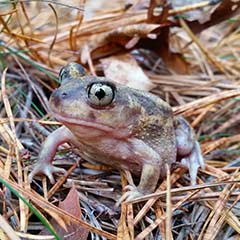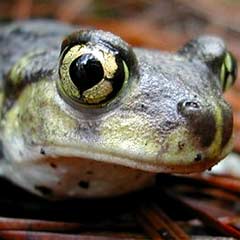
Eastern spadefoot toad
Eastern Spadefoot Toad Conservation
Since 2009, we’ve worked with MassWildlife and Mass Audubon to boost beleaguered populations of Massachusetts’ most unique amphibian, the eastern spadefoot toad, by monitoring, creating, and improving their breeding habitat.
Spadefoot toads are not true toads or true frogs, but they are truly interesting! Palm-sized, with cat-like pupils, these fossorial frogs spend much of their time buried under sand. They're also gamblers: their breeding strategy involves choosing small, extremely ephemeral pools. If the weather cooperates, the small pools ensure a warm and predator-free sanctuary for their young. But not enough rain can spell danger for the aquatic tadpoles. Spadefoot toads have been hit hard by climate change, habitat fragmentation, and fill-in of their breeding pools, and are considered Threatened and a Species of Greatest Conservation Need in MA.
Starting in 2009, we partnered with Mass Audubon’s Long Pasture Wildlife Sanctuary to help restore the eastern spadefoot toad to areas of its former range. Under the leadership of sanctuary director Ian Ives, and with the help of noted wetland restoration expert Thomas Biebighauser, we helped create 13 new, small vernal pools at Ashumet Holly and Long Pasture Wildlife Sanctuaries, and stocked the pools with more than 8,000 spadefoot toadlets, rescued from drying pools and raised by local schoolchildren. This pilot reintroduction project ran through 2018. The effort took years to bear fruit – but in 2021, adults were recorded calling from the brand new pools, and in 2022, the spadefoot toads bred successfully.
Zoo New England biologists continue to monitor for spadefoot toads at several sites around Massachusetts, and assist with habitat management.



